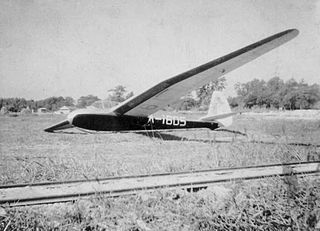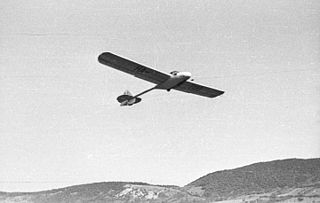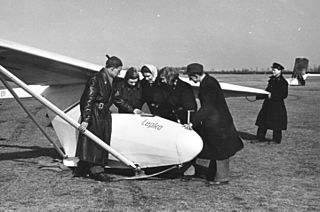Related Research Articles

The Schneider ES-65 Platypus is a two-seater unflapped glider designed and built by Edmund Schneider Ltd in Australia. A single prototype was built, which remains operational as of 2012.
The Slingsby Type 26 Kite 2 was a post World War II development of the Slingsby Kite, a single seat medium performance sailplane. It sold in small numbers.
The Alpaero Exel is a French single seat, single engine pusher pod-and-boom kit-built ultralight motor glider. About 10 had been produced by 2005.
The Horikawa H-22B-3 is a simple, open frame, two seat primary trainer glider designed and built in Japan in the 1950s.

The Maeda 703 was one of the first indigenous Japanese gliders, a high performance single seat aircraft which first flew in 1940. Three were built, two with gull wing wings; one of these set a national endurance record in 1941.

The Caudron C.800, at first also known as the Epervier is a French two seat training glider, designed and first flown during World War II and put into large scale post-war production. It was the dominant basic training glider with French clubs until the 1960s and several still fly.
The Bonomi BS.19 Alca was a single seat, tractor configuration motor glider, designed and built in Italy shortly before World War II. It had an unusual retractable undercarriage used only for take-offs. Only one was built.
The Teichfuss Allievo Pavullo was an Italian single seat open frame primary glider, designed by Luigi Teichfuss of Pavullo and first flown in 1940. It was sold in two versions, strut and cable braced. A single two seat variant was also built.
The Kortenbach & Rauh Kora 1 was an unusual twin boom, pusher configuration motor glider, designed and built in Germany in the 1970s and intended as a training aircraft.
The VFW-Fokker FK-3 is a single seat competition glider, built in Germany in the late 1960s. It had success at the Italian and Austrian national contests of 1968, resulting in a short production run the following year.
The IIL IS-7 was a two-seat, sailplane designed by Iosif Șilimon and built in Romania in the late 1950s. Only one prototype was built.
The IIL IS-8 was a two-seat sailplane designed by Iosif Șilimon and built in Romania in 1960. They served with Romanian gliding clubs.
The Schneider Grunau 8 was a simple, two-seat trainer glider designed and built in Germany in the early 1930s.
The Schneider ES49 is a two-seat glider trainer, designed, first flown in late August 1951 and commercially produced in Germany but later built from plans by gliding clubs in Australia. A major redesign there led to the ES49B Kangaroo.

The Rubik R-03 Szittya I was a Hungarian single-seat sailplane flown in the late 1930s. The design was developed through three improving variants. though only one of each was built.

The Rubik R-15 Koma (Godfather) was a side-by-side seat Hungarian training glider designed to introduce pilots to winch-launching techniques. A second, very similar but single seat design, the Rubik R-16 Lepke, provided follow-up solo experience of the same techniques. Pairs were widely used by Hungarian glider clubs post-war, with 65 of each produced.

The Rubik R-16 Lepke (Butterfly) was a single seat Hungarian training glider designed to follow the very similar but two seat Rubik R-15 Koma in a winch-launch training programme. The Lepke provided solo experience of the techniques learned with an instructor in an aircraft with similar handling characteristics. That done, the Lepke could be used as a standard trainer to take its pilot to C-certificate level. The pair were widely used by Hungarian glider clubs post-war, with sixty-five of each produced.
The Rubik R-17 Móka (Joy) was a Hungarian aerobatic glider designed in the late 1930s. One prototype was built and first flown in 1944 but was destroyed near the end of World War II. Two more, with modified ailerons and a new fuselage, were built in 1950 but were abandoned after a fatal accident.

The Kemény K-02 Szellő was a Hungarian training glider from the late 1940s. It was originally designed for a national contest to build a primary trainer but when this was won by the Rubik R-16 Lepke it was resigned to have more advanced soaring capability which could take pilots to their Silver C badge. Ninety were produced.
The PZL M-3 Pliszka (Wagtail) was the first all-metal Polish glider. Three were built but its performance, particularly its glide ratio, was not good enough for it to be produced for Polish clubs.
References
- ↑ Donaldson, Graham (2000). "The Japanese paratroopers in the Dutch East Indies, 1941-1942". Archived from the original on 2015-07-08. Retrieved 2007-04-29.
- 1 2 3 4 Mrazek, James E. (1977). Fighting gliders of World War II . London: Hale. pp. 84-86. ISBN 978-0312289270.
- 1 2 3 "Maeda Ku.1". www.airwar.ru (in Russian). Retrieved 18 March 2018.
- ↑ Skrzypacz, Marcin. "Maeda Ku-1 (Type 2)". Archived from the original on May 17, 2008. Retrieved 2007-04-29.